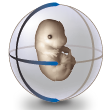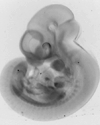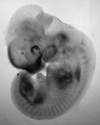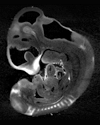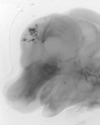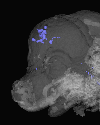Transmission Imaging
In this arrangement a light source and diffuser are positioned "behind" the specimen. The images record how much light passes through the specimen, such that darker regions indicate more tissue and/or darker tissue. The back-projection algorithm is able to distinguish between these two alternatives by incorporating the projection data oriented at many angles through the specimen. As a result, tissue which is of a fixed absorption but is arranged into complex shapes (such as an unstained embryo) can be reconstructed to determine its 3-D structure. Alternatively, the tissue can be stained, such some different regions are darker than others, and these dark regions will be correctly localised in the 3-D reconstruction. This allows us to map patterns such as DIG-labelled whole-mount in-situ hybridisations stained with BCIP/NBT, and also b-gal staining from LacZ reporter constructs.
|
||
|
|
|
|
|
